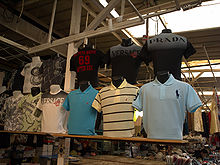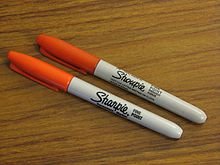- Counterfeit
-
For other uses, see Counterfeit (disambiguation).Not to be confused with Counterfit, a band.
 Counterfeit products at a flea market.
Counterfeit products at a flea market.
To counterfeit means to illegally imitate something. Counterfeit products are often produced with the intent to take advantage of the superior value of the imitated product. The word counterfeit frequently describes both the forgeries of currency and documents, as well as the imitations of works of art, toys, clothing, software, pharmaceuticals, watches, electronics and company logos and brands. In the case of goods, it results in patent infringement or trademark infringement. Additionally, it is fairly common in big cities for would-be criminals to sell counterfeit illegal drugs, such as a bag of pure baking soda sold as cocaine or heroin, or a bag of oregano sold as marijuana. This takes advantage of the extremely high prices of illicit drugs and the relatively low prices of common materials such as baking soda and oregano, as well as taking advantage of the similarity in appearances that certain house-hold items share with certain illicit drugs.
The counterfeiting of money is usually attacked aggressively by governments. The counterfeiting of goods is countenanced by some governments.
Contents
Counterfeiting of money or government bonds
Main article: Counterfeit moneyCounterfeit money is currency that is produced without the legal sanction of the state or government and in deliberate violation of the laws thereof; the United States Secret Service, better known as the official bodyguard detail for the President and/or the Vice President of the United States, their families, and/or other officials/dignitaries and/or their families, was initially organized primarily to combat the counterfeiting of American money; counterfeit government bonds are public debt instruments that are produced without legal sanction, with the intention of "cashing them in" for authentic currency or using them as collateral to secure legitimate loans or lines of credit.
Counterfeiting of documents
Main article: ForgeryForgery is the process of making or adapting documents with the intention to deceive. It is a form of fraud, and is often a key technique in the execution of identity theft. Uttering and publishing is a term in United States law for the forgery of non-official documents, such as a trucking company's time and weight logs.
Questioned document examination is a scientific process for investigating many aspects of various documents, and is often used to examine the provenance and verity of a suspected forgery. Security printing is a printing industry specialty, focused on creating illegal documents which are difficult to forge.
Counterfeiting of consumer goods
Main article: Counterfeit consumer goodsA Sharpie marker, next to a "Shoupie" marker.
The spread of counterfeit goods (commonly called "knockoffs") has become global in recent years and the range of goods subject to infringement has increased significantly. Apparel and accessories accounted for over 50 percent of the counterfeit goods seized by U.S Customs and Border Control. According to the study of Counterfeiting Intelligence Bureau (CIB) of the International Chamber of Commerce (ICC), counterfeit goods make up 5 to 7% of World Trade, however these figures cannot be substantiated due to the secretive nature of the industry.[1] A report by the Organisation for Economic Co-operation and Development indicates that up to US$200 Billion of international trade could have been in counterfeit and illegally-copied goods in 2005.[2] In November 2009, the OECD updated these estimates, concluding that the share of counterfeit and pirated goods in world trade had increased from 1.85% in 2000 to 1.95% in 2007. That represents an increase to US$250 billion worldwide.[3]
In a detailed breakdown of the counterfeit goods industry, the total loss faced by countries around the world is $600 Billion, with the United States facing the most economic impact.[4] When calculating counterfeit products, current estimates place the global losses at $400 Billion.[5] On November 29, 2010, the Department of Homeland Security seized and shut down 82 websites as part of a U.S. crackdown of websites that sell counterfeit goods, and was timed to coincide with "Cyber Monday," the start of the holiday online shopping season.[6]
Some see the rise in counterfeiting of goods as being related to globalization. As more and more companies, in an effort to increase profits, move manufacturing to the cheaper labour markets of the third world, areas with weaker labour laws or environmental regulations, they give the means of production to foreign workers. These new managers of production have little or no loyalty to the original corporation. They see that profits are being made by the global brand for doing little (other than advertising) and see the possibilities of removing the middle men (i.e. the parent corporation) and marketing directly to the consumer.
Certain consumer goods, especially very expensive or desirable brands or those that are easy to reproduce cheaply, have become frequent and common targets of counterfeiting. The counterfeiters either attempt to deceive the consumer into thinking they are purchasing a legitimate item, or convince the consumer that they could deceive others with the imitation. An item which makes no attempt to deceive, such as a copy of a DVD with missing or different cover art, is often called a "bootleg" or a "pirated copy" instead.
Most counterfeit goods are produced in China, making it the counterfeit capital of the world. In fact, the counterfeiting industry accounts for 8% of China's GDP.[7][8] Joining China are North Korea and Taiwan. Some counterfeits are produced in the same factory that produces the original, authentic product, using inferior materials. Another strange new trend in counterfeiting, especially seen in consumer electronics, is the manufacture of entirely novel products using poor quality materials or, more often, incorporating desirable features not present in a brand's authentic product line and then including prominent and fake brand names and logotypes to profit from brand recognition or brand image. An example would be imitation "Nokia" cellular phones with features like WiFi, touchscreens or TV, which are unavailable in authentic originals. Another example would be imitation "iPod" MP3 players whose power cells or batteries are removable and replaceable, whereas in authentic originals the power cells or batteries are permanently installed.
In the United States, a federal crackdown on counterfeit imports is driving an increase in domestic output of fake merchandise, according to investigators and industry executives. Raids carried out in New York City resulted in the seizure of an estimated $200 Million in counterfeit apparel, bearing the logos of brands such as "The North Face," "Polo," "Izod Lacoste," "Rocawear," "Seven for all Mankind," and "Fubu." One of the largest seizures was a joint operation in Arizona, Texas and California that seized seventy-seven containers of fake "Nike Air Jordan" shoes and a container of "Abercrombie & Fitch" clothing, valued at $69.5 Million. Another current method of attacking counterfeits is at the retail level. Fendi sued the "Sam's Club" division of Wal-Mart Stores, Inc. for selling fake "Fendi" bags and leather goods in five states. Sam's Club agreed to pay Fendi a confidential amount to settle the dispute and dismiss the action. In the case Tiffany v. eBay, Tiffany & Co. sued auction site EBay for allowing the sale of counterfeit items. Gucci filed suit against thirty websites in the United States and is currently[when?] in the process of suing one hundred more.[citation needed]
A number of companies involved in the development of anti-counterfeiting and brand protection solutions have come together to form special industry-wide and global organisations dedicated to combating the so-called "brand pirates". These are the International Authentication Association [1] and the International Hologram Manufacturers Association [2]. Other companies and organizations have established web-based communities that provide a framework for crowd-sourced solutions to counterfeiting. One such free community, Collectors Proof [3] enables manufacturers and users alike to associate unique identification numbers to virtually any item so that each new owner can update its chain of custody. Because quality counterfeit items are often difficult to discern from authentic goods, this approach enables potential customers to access an item's current and previous owners - its provenance - prior to purchase.
To try to avoid this, companies may have the various parts of an item manufactured in independent factories and then limit the supply of certain distinguishing parts to the factory that performs the final assembly to the exact number required for the number of items to be assembled (or as near to that number as is practicable) and/or may require the factory to account for every part used and to return any unused, faulty or damaged parts. To help distinguish the originals from the counterfeits, the copyright holder may also employ the use of serial numbers and/or holograms etc., which may be attached to the product in another factory still.
See also
References
- ^ ICC Counterfeiting Intelligence Bureau (1997), Countering Counterfeiting: A Guide to Protecting and Enforcing Intellectual Property Rights, United Kingdom.
- ^ "The Economic Effect of Counterfeiting and Piracy, Executive Summary" (PDF). OECD, Paris. 2007. http://www.oecd.org/dataoecd/13/12/38707619.pdf. Retrieved 2007.
- ^ "Magnitude of counterfeiting and piracy of tangible products – November 2009 update" (PDF). OECD, Paris. 2009. http://www.oecd.org/dataoecd/57/27/44088872.pdf. Retrieved 2010.
- ^ "Havocscope Counterfeit and Piracy Markets by Countries". http://www.havocscope.com/activities/counterfeit-markets-by-countries/. Retrieved April 14, 2010.
- ^ "Havocscope Counterfeit and Piracy Markets by Products". http://www.havocscope.com/activities/counterfeit-and-piracy/. Retrieved April 14, 2010.
- ^ "U.S. Shutters 82 Sites in Crackdown on Downloads, Counterfeit Goods" Wired magazine, Nov. 29, 2010
- ^ "Intellectual Property Rights". http://www.asiabusinesscouncil.org/docs/IntellectualPropertyRights.pdf. Retrieved 15 May 2010.
- ^ "MIT CIS: Publications: Foreign Policy Index". http://web.mit.edu/cis/fpi_china.html. Retrieved 15 May 2010.
- World Cup Fakes War Could Be Won On Penalties [4]
- Detecting the Truth: Fakes, Forgeries and Trickery, a virtual museum exhibition at Library and Archives Canada
4The Dynamics of Fashion Third Edition; Fairchild Books, Inc. New York; Elaine Stone, professor emerita; fashion Institute of technology, New York
External links
Categories:- Forgery
- Commercial crimes
- Counterfeiters
- Organized crime activity
Wikimedia Foundation. 2010.

